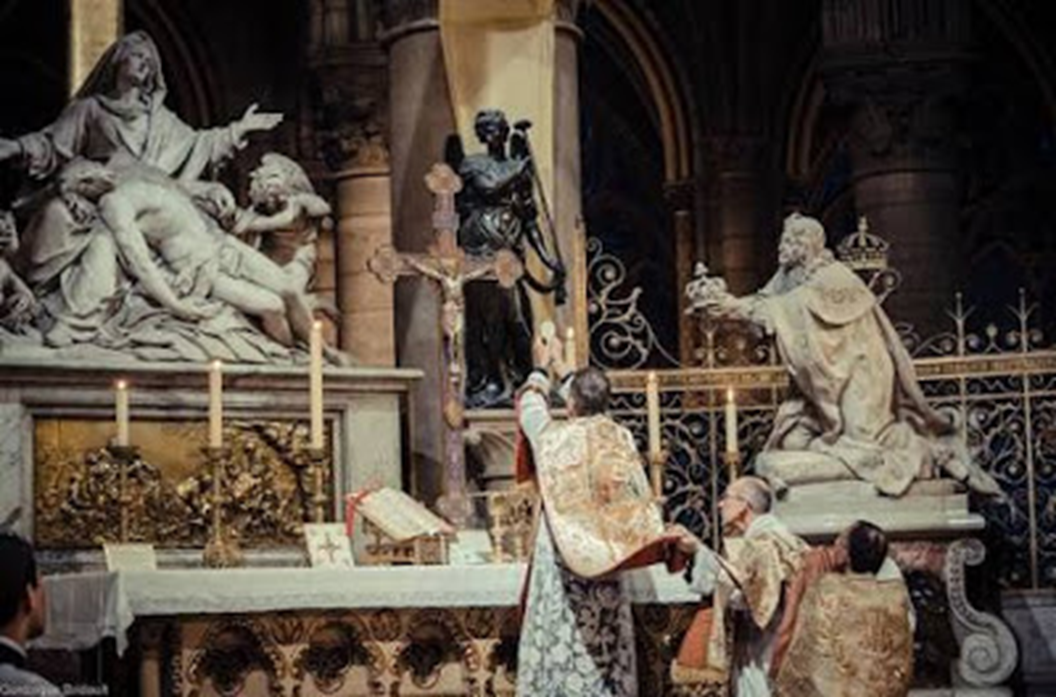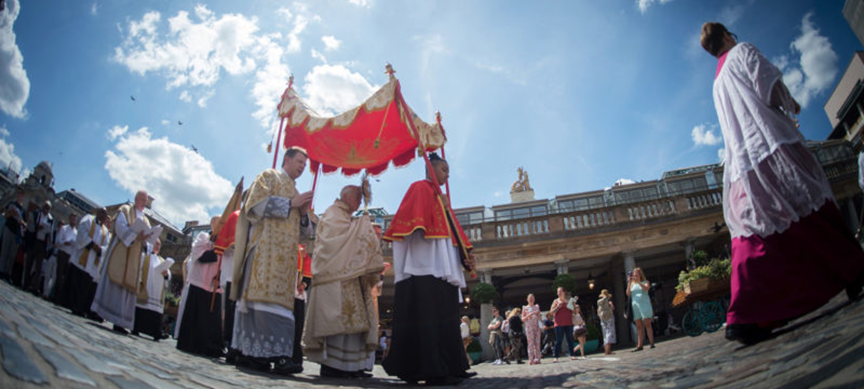 Surprise article at Commonweal
Surprise article at Commonweal
about attending a traditional Mass

June 16, 2018
There was a surprise at
Commonweal, which generally leans left and against Tradition. It is about a week old, but I missed it: I don’t read
Commonweal unless I can’t avoid it.
It starts out with an off-putting reference to the disastrous film
Silence by Shusaku Endo, but it improves. The writer juxtaposes it with the silence of the traditional Roman Rite. Here are excerpts:
Silent grace:
Finding peace in the Latin Mass
By Michael Wright
...There was never silence or stillness at Mass for me growing up. I was, and am, afflicted with attention deficit disorder. For a long time, my family worshipped in the gym of the local Catholic school, crammed into folding chairs, kneeling, standing, and watching Father Joe turn purple during a homily on compassion.
For me, Mass was a test of endurance. I could never find the peace the nuns told us about in CCD. Although I’d learned what each part of the Mass meant, I couldn’t linger on what was happening in front of me. I raced ahead in the missalette, willing the priest to speak as fast as I read. My restlessness never left enough room for grace to find its way in.
...Then, three or four years ago, on a whim, I attended Latin Mass at St. Mary’s Cathedral in Austin, Texas. Just a block from the State Capitol, St. Mary’s is modest, with bare wood pews and a sanctuary set back from the congregation. I paged through a blue book that had Latin text on one page and English text on the facing page, with stage directions and illustrations in the margins.
Despite Catholic school and all that CCD, I didn’t realize until then that the Novus Ordo is not a straight translation to the vernacular [of the traditional Mass]. The Latin readings confused me; I couldn’t tell, for example, just when the Trans-substantiation was occurring. [But can't you recognize the Consecration????] But I knew without looking at the translation when we were saying “Lamb of God” and the Lord’s Prayer.
I watched these strange ways of doing familiar things. The priest faced away from us. We knelt to take communion on the tongue. All the altar servers were male. I bowed at the priest during the recessional, incense still in my nostrils. Then I did something I’d never done after Mass. I sat in a pew, and I felt it: peace.
He goes on to talk about his life, the older Mass, and even critiques a little the likes of that mass constructor of straw-men of Mass destruction, Massimo “Beans” Faggioli.
And then…
...But the Latin Mass has a place for me. I don’t think it’s the future of the church, even though [!] I’ve noticed the pews are filled with fellow Gen X-ers and their children. (My nine-year-old daughter has been to more Latin Masses than English.)
The English Mass is too easy; the unfamiliarity of the Latin Mass requires me to quiet my mind, to focus, to attend to my faith in a way that Mass in English does not.
It isn’t a refuge from a changing world, but a base from which to engage it. My faith is not certain, and my doubt leads to questions. The Latin Mass welcomes me into the silence that allows me to seek the answers.
Interesting, no? I applaud his honesty.
His observation that “the English Mass is too easy” hits several nails on the head all at once. Frankly, in no way do people benefit from futile attempts to make what is really hard - Mystery - easy, even simplistic.
The author observes that the people who attend “the Latin Mass” where he goes, “seem to be a community with a community” and that they want a parish of their own.
I often write about the importance of being involved in the whole life of the parish where the TLM is celebrated. On the other hand… I fully understand that people who have what Pope St. John Paul called “legitimate aspirations” should want a parish where they can have the whole package, where they have consistency without being made to feel like second class citizens.
It is understandable that they would want to have a parish where the Mass they desire, quite rightly, to attend isn’t relegated to the edges of Sundays. They would prefer to have all the sacraments according to the older rites, including, for example, absolution in the confessional. They would like to have traditional devotions that don’t have to be rediscovered piecemeal.
At times I have written (i.e., whined a little) about those who prefer the older forms and who disappear between Sundays.
On the other hand, even factoring in the fact that people are busy, and sometimes live at quite a distance from the church where they have the older Mass, I am also cognizant of the legitimate aspirations that they have and also suffer with.
Moving on, the writer observes that the pews are filled with young families. I observe that recent research suggests that there will be traumatic consequences for church attendance in the next few years because the majority of young people don’t identify with any religion. Moreover, large numbers of priests will exit active ministry one way or another.
On the other hand, traditional groups of priests are growing and young people are filling pews at traditional Masses. Where tradition is tried, it seems to work.
The future?
New Catholic at Rorate caeli comments on the article:
The Traditional Mass:
Not about ideology -
It's about Truth and Beauty

June 16, 2018
Commonweal is a journal known, at least since the last Council, for its extreme liberal positions.
So it was not without considerable surprise that this past week the journal published a text favorable to the Latin Mass: it is a personal account of the author's discovery of the Latin Mass.
As many modern Catholics, the author assumed that the New Mass of Paul VI was merely a translation of the old rite -- and, of course, nothing could be further from the truth.
The New Mass is a completely new concoction, completely unrelated to the Tradition of the Church. What was created, under the guise of introducing the vernacular, was a messy product of the 1960s, the disgraceful decade of cultural revolution.
The Commonweal piece is particularly important to us because it shows it is possible to have a different sensibility to certain themes of Catholic social doctrine and still appreciate the Mass that was the same Mass and the only known Mass to all the great Catholic social reformers [and thinkers and saints] of the Latin Church.
The Traditional Mass really is not about a particular kind of political preference, but it is all about love for the most sacred thing on Earth: the Blessed Sacrament.
The Traditional Latin Mass is the birthright of each and every Catholic. To each one who discovers or rediscovers it, regardless of their political leanings, we say: Welcome Home!
 Corpus Christi procession at Covent Garden, 2018.
Popular devotions are back
Corpus Christi procession at Covent Garden, 2018.
Popular devotions are back
As a new generation of priests revive beauty
in the liturgy, is the Church undergoing a restoration?
by Tim Stanley

June 16, 2018
I attended the recent Mass for the new shrine at Corpus Christi, Covent Garden, and it was a testament to the glory of the service that I didn’t fall asleep once. I like my Masses Latin, low and short. This lasted two-and-a-half hours. But it was spellbinding, with superb music and a witty sermon by Cardinal Nichols.
About three-quarters of the way through, we processed around Covent Garden with the Blessed Sacrament. I personally didn’t see any onlookers kneel (I’m told one or two did), but then I didn’t see any men selling apples and pears either. Covent Garden used to be a real market where you could weigh and squeeze fresh fruit. Today it’s a tourist shopping centre.
The Catholic Church is breathing life back into Old England, and Corpus Christi Church is an obvious place to start. First opened in 1874, it was built in reparation for sins committed against the Blessed Sacrament during the Reformation. Sadly, it fell into decline and disrepair.
The truth is that the English Church has been through two iconoclastic periods: the 16th-century Protestant one and the liberal revolution of the Seventies, which did just as much to strip our altars and degrade our churches. The latter reforms were sadder because the Catholics inflicted them on themselves. There was no glorious martyrdom this time around. Just self-harm.
Today, however, a new spirit is stirring. Popular devotions are back; confessions are on the up; and a new generation of priests is reviving beauty and the Old Rite. It’s a restoration. In 10 years’ time, the Corpus Christi procession will be a feature of many local churches – and the English unbelievers will watch and think, “Ooooh, that looks interesting. How do I join in?”
That’s the way you convert. With magnificence. [A naive and simplistic statement, I think. It's not the magnificence of the rite that counts - it's the beauty it conveys, the via pulchritudina to faith. Liturgy can be simple but beautiful; it does not have to be magnificent. But if it is, too, then it is truly glorious and a real foretaste of the heavenly liturgy... Also, it's great to indulge in wishful thinking as Mr. Stanley does, speaking of a 'restoration', but can the efforts of a heroic few in the new generations prevail over the line of least resistance that is the default position of most people in the face of the overt, persistent anti-Catholic pressure brought to bear by Bergoglio and his minions?] [Modificato da TERESA BENEDETTA 17/06/2018 10:49]